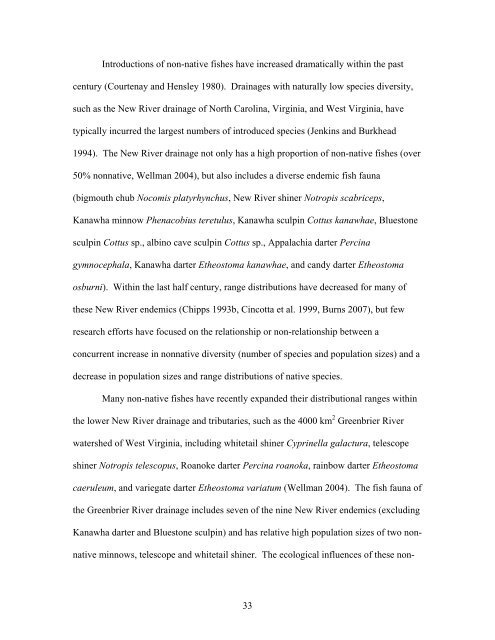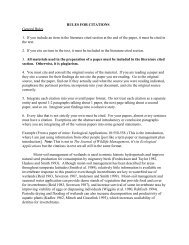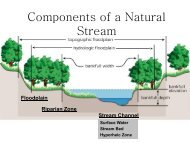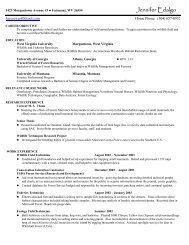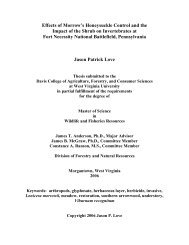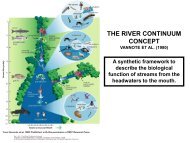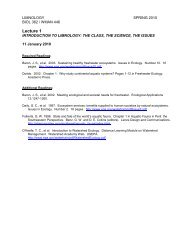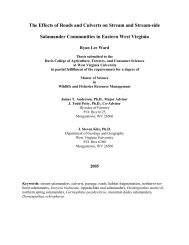An Experimental Study of Vertical Habitat Use and Habitat Shifts in ...
An Experimental Study of Vertical Habitat Use and Habitat Shifts in ...
An Experimental Study of Vertical Habitat Use and Habitat Shifts in ...
Create successful ePaper yourself
Turn your PDF publications into a flip-book with our unique Google optimized e-Paper software.
Introductions <strong>of</strong> non-native fishes have <strong>in</strong>creased dramatically with<strong>in</strong> the past<br />
century (Courtenay <strong>and</strong> Hensley 1980). Dra<strong>in</strong>ages with naturally low species diversity,<br />
such as the New River dra<strong>in</strong>age <strong>of</strong> North Carol<strong>in</strong>a, Virg<strong>in</strong>ia, <strong>and</strong> West Virg<strong>in</strong>ia, have<br />
typically <strong>in</strong>curred the largest numbers <strong>of</strong> <strong>in</strong>troduced species (Jenk<strong>in</strong>s <strong>and</strong> Burkhead<br />
1994). The New River dra<strong>in</strong>age not only has a high proportion <strong>of</strong> non-native fishes (over<br />
50% nonnative, Wellman 2004), but also <strong>in</strong>cludes a diverse endemic fish fauna<br />
(bigmouth chub Nocomis platyrhynchus, New River sh<strong>in</strong>er Notropis scabriceps,<br />
Kanawha m<strong>in</strong>now Phenacobius teretulus, Kanawha sculp<strong>in</strong> Cottus kanawhae, Bluestone<br />
sculp<strong>in</strong> Cottus sp., alb<strong>in</strong>o cave sculp<strong>in</strong> Cottus sp., Appalachia darter Perc<strong>in</strong>a<br />
gymnocephala, Kanawha darter Etheostoma kanawhae, <strong>and</strong> c<strong>and</strong>y darter Etheostoma<br />
osburni). With<strong>in</strong> the last half century, range distributions have decreased for many <strong>of</strong><br />
these New River endemics (Chipps 1993b, C<strong>in</strong>cotta et al. 1999, Burns 2007), but few<br />
research efforts have focused on the relationship or non-relationship between a<br />
concurrent <strong>in</strong>crease <strong>in</strong> nonnative diversity (number <strong>of</strong> species <strong>and</strong> population sizes) <strong>and</strong> a<br />
decrease <strong>in</strong> population sizes <strong>and</strong> range distributions <strong>of</strong> native species.<br />
Many non-native fishes have recently exp<strong>and</strong>ed their distributional ranges with<strong>in</strong><br />
the lower New River dra<strong>in</strong>age <strong>and</strong> tributaries, such as the 4000 km 2 Greenbrier River<br />
watershed <strong>of</strong> West Virg<strong>in</strong>ia, <strong>in</strong>clud<strong>in</strong>g whitetail sh<strong>in</strong>er Cypr<strong>in</strong>ella galactura, telescope<br />
sh<strong>in</strong>er Notropis telescopus, Roanoke darter Perc<strong>in</strong>a roanoka, ra<strong>in</strong>bow darter Etheostoma<br />
caeruleum, <strong>and</strong> variegate darter Etheostoma variatum (Wellman 2004). The fish fauna <strong>of</strong><br />
the Greenbrier River dra<strong>in</strong>age <strong>in</strong>cludes seven <strong>of</strong> the n<strong>in</strong>e New River endemics (exclud<strong>in</strong>g<br />
Kanawha darter <strong>and</strong> Bluestone sculp<strong>in</strong>) <strong>and</strong> has relative high population sizes <strong>of</strong> two nonnative<br />
m<strong>in</strong>nows, telescope <strong>and</strong> whitetail sh<strong>in</strong>er. The ecological <strong>in</strong>fluences <strong>of</strong> these non-<br />
33


